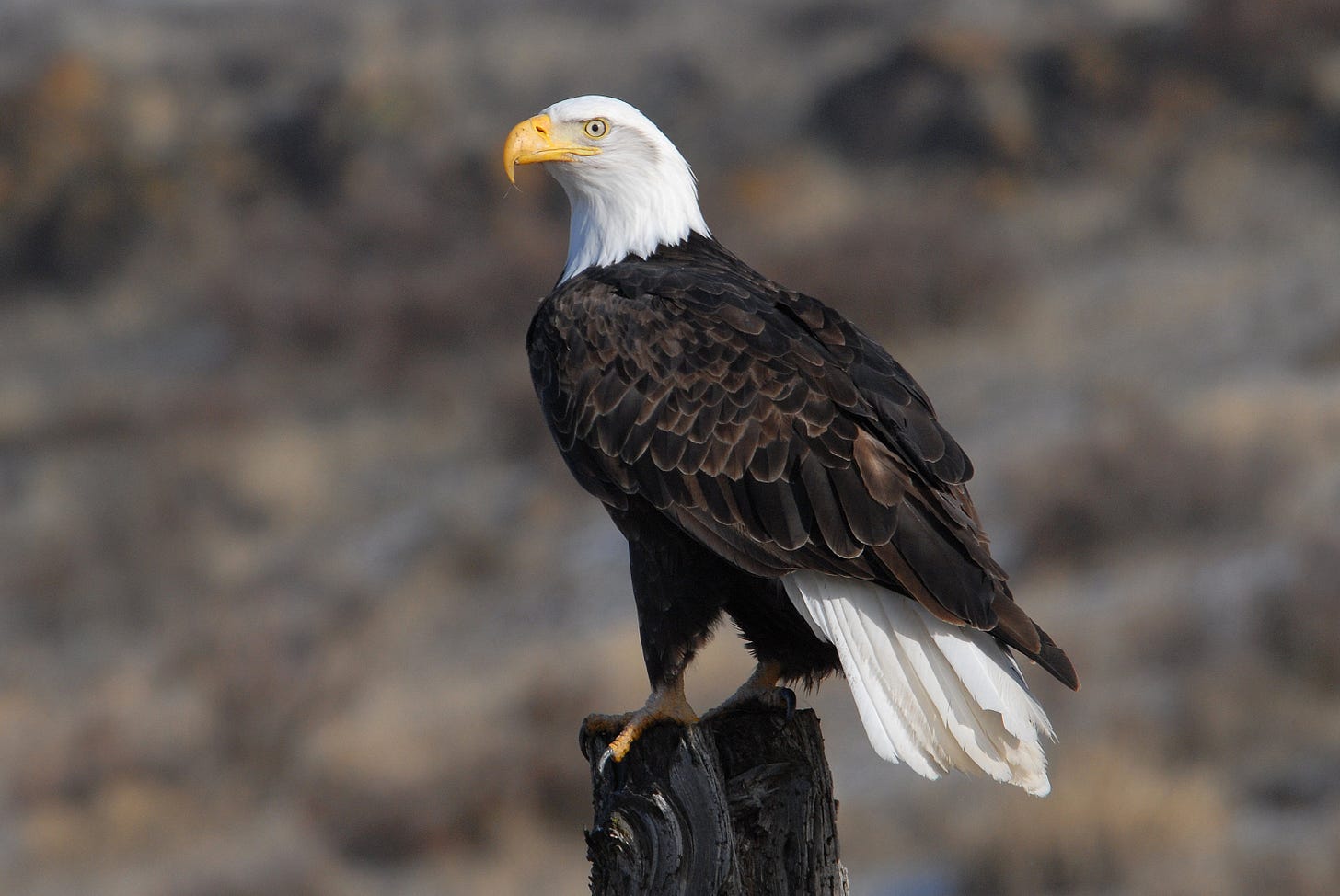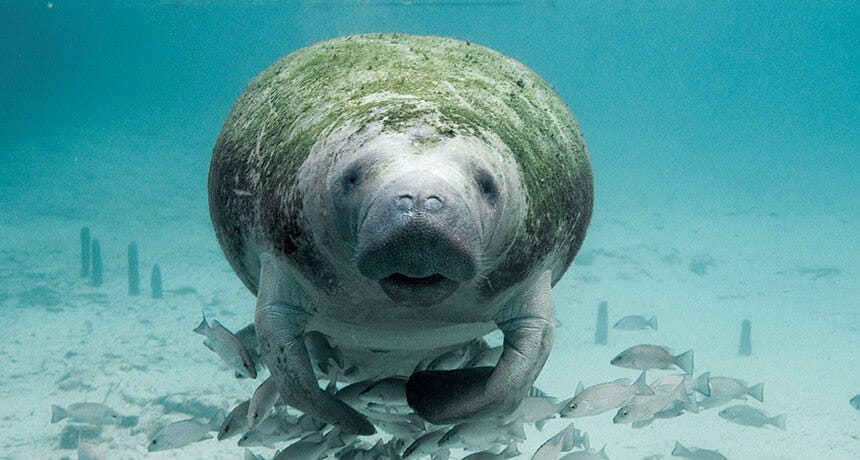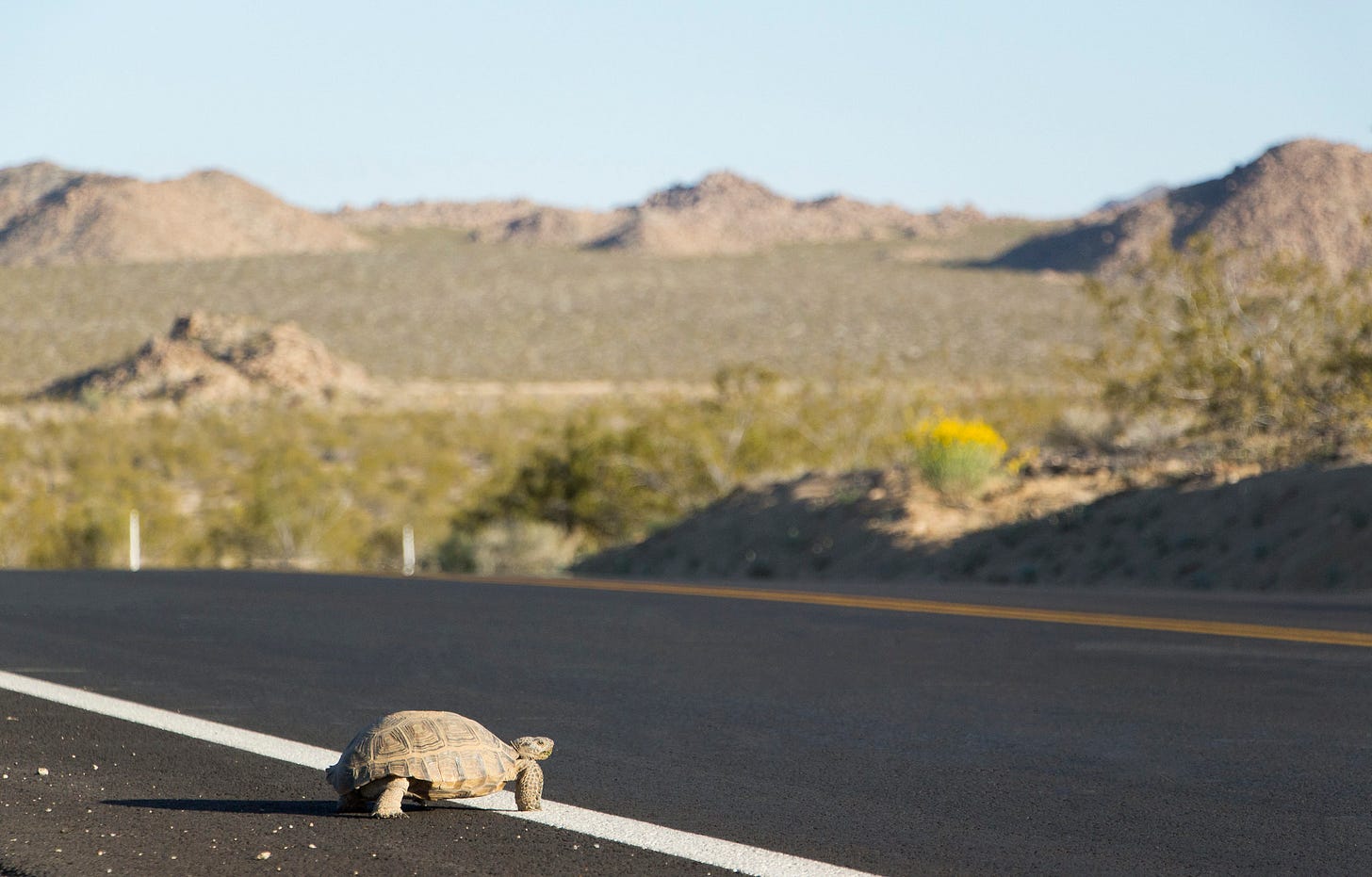A Right to Be in this World
1/18/24 – On the 50th anniversary of the Endangered Species Act, part 3

Hello everyone:
As always, please remember to scroll past the end of the essay to read some curated Anthropocene news.
Now on to this week’s writing:
Want an elegant one-sentence summary of the Endangered Species Act? “The law says that all living things have a right to be in this world.”
All living things have a right to be in this world. That’s the ecologist and author Carl Safina in an article last year, noting that the ESA “came from a more generous time” when America “had the power and the confidence” to speak with a bipartisan voice in support of the fabric of life.
But thanks to a remarkably devious and successful long-term strategy from an alliance of conservatives and industry, the balance of power has shifted significantly toward the anti-environmental right in recent decades. This shift is most concerning at the Supreme Court, as I outlined last week. And it is largely contrary to the wishes of the American public, most of whom like the laws that safeguard the lives that sprout, fly, lope, and swim all around us.

Americans may deeply support conservation, but things at the shallow (i.e. political) end of the pool could get worse soon. As I write this, according to a recent Defenders of Wildlife email, some members of Congress are trying to attach fifteen anti-ESA policy riders to the House FY2024 Interior Appropriations Bill. They also note that there was an average of one new poisonous rider per week in 2023, “aimed at weakening the ESA, including protections for individual species.” (You can speak up against these riders here.) The Trump administration proposed severe restrictions on the government’s ability to protect critical habitat for endangered species, and a second Trump administration would do much, much worse.
And as the latest Volts podcast with David Roberts makes clear, conservative justices on the Supreme Court may soon ignore decades of precedent and gut the “Chevron doctrine.” That doctrine, forty years old and rooted in a century of judicial habit, determined that judges should defer to the expertise and interpretation of federal agencies on matters in which they’ve been given jurisdiction by Congress. If Chevron is undermined, it will likely weaken the power of the federal government to defend the right of living things to be in this world. The first arguments in the case are being heard as I write this, and it doesn’t look good.
But let’s stick to the slightly sunnier side of the aisle this week. There we can find the wonderful biologist and writer Bryan Pfeiffer talking about the ESA in one of his older essays:
The Endangered Species Act is a statement of our aspirations to live within our means in nature. As we encroach on plants and wildlife, as we push species to their limits, the act becomes more a statement about us. It recognizes that we can step back from our giant destructive footprints and try to make amends.
The challenge before us is to make amends fast enough to keep up with the accelerating extinctions beneath our heels. (I’m reminded of how Kafka boiled down the human problem into a typically gnomic line: “The evolution of mankind – a growth of death-force.”) There is so much great and optimistic work being done to slow or reverse biodiversity loss, but as I described last week, there are also a lot of political, industrial, cultural, and climatic winds in the Anthropocene blowing in the wrong direction.
And, amid our ecological realities, there is a great unknown: We don’t really know how many of our fellow travelers we’re already erasing, nor how fast we’re erasing them. Our estimates are certainly underestimates, given how little of the living world we’ve actually mapped. I’m thinking especially about “the little things that run the world,” per E.O. Wilson, whether insects or microbes.
From my reading, there seems to be a consensus among those who know and love the ESA: it has been quite successful, it must be defended, but as it’s currently being implemented it isn’t enough for the task ahead. Jamie Rappaport Clark of Defenders of Wildlife said that “the Endangered Species Act is the last stop. It has been doing a dramatically good job to prevent extinction, but it can't do this by itself.”
Safina compared the ESA to a health-care system built only of emergency rooms. Instead, he said, “we should have an abundant species act, not just an Endangered Species Act.” Likewise, Ben Goldfarb, in his excellent book Eager (on the ecological necessity of bringing beavers back into North American and European landscapes) describes the ESA as “our most powerful environmental law,” essential for keeping species from disappearing, “but there’s no parallel requirement that we restore species to their former abundance.”
So, what does the ESA need to do the greater work, to properly defend the living world’s right to exist? Partly, of course, it’s a matter of continuing to turn empathy and ecological knowledge into legislation that drives restoration and rewilding. But there’s much more, including funding, technology, social engineering, planning ahead for what climate change will do to living communities, and making the ESA part a larger coordinated effort on biodiversity at national and global scales. I’ll sketch some of that out here.
More than Species
In the Anthropocene, the threats are to entire natural systems, not just species. There are no places, regions, ecosystems, or habitats on the planet which are not impacted, many catastrophically, by our industrialized, resource-hungry civilization. Endangered species aren’t plants and animals that have fallen through the cracks; they are – choose your cliché – the tip of the iceberg, the first dominoes to fall, the canaries coated in coal dust.
The acceleration of extinctions means that the administration of the ESA should be broadened to work more often toward landscape-scale conservation. The more critical habitat identified, the better for all of us. Protecting and restoring some of the Earth’s abundance is the necessary goal, rather than merely keeping freshwater mussels, ‘akikiki, and northern right whales on oxygen in the ER. No species exists apart from their environment.
The good news is that protection of critical habitat was written into the ESA from the start. As the Dept. of Interior reminds us, the law’s purpose was in part “to promote the conservation of ecosystems and habitats necessary for the survival of those species.” And as the Center for Biological Diversity further explains,
the original definition of critical habitat said it must include all areas deemed important to a species’ survival or recovery, whether the species currently resides in those areas, historically resided in those areas, uses those areas for movement, or needs them for any other reason.
You can dive into maps of designated critical habitat from the USFWS (U.S. Fish and Wildlife Service) and NMFS (National Marine Fisheries Service, which administers the ESA for ocean species). Use the maps to zoom in and identify specific protected areas that interest you. (Take a moment, too, to zoom in on the disturbingly high number of threatened and endangered species in Hawaii.) But the Center for Biological Diversity spends a lot of its litigious energy trying to push USFWS and NMFS to designate critical habitat for threatened and endangered species, saying that “Ever since the Endangered Species Act was passed in 1973, the agencies (especially the Fish and Wildlife Service) often drag their feet on designating critical habitat or even refuse to designate it altogether.”
Last September, the ESA-at-50 Coalition (more than 250 environmental groups, including CBD and Defenders), sent a letter to President Biden advising him on the future of the ESA. It’s well worth your time to read it. Titled “Meeting the Challenges of the Biodiversity and Extinction Crisis Over the Next 50 Years,” the letter suggests, among other things, that USFWS and NMFS designate protections for species not simply for their individual survival but based on the ecological roles those species play in their habitat, “as the Act originally envisioned.”
It’s a good reminder that in the real world, species are not isolated things. They’re a set of relationships.
More Funding
If the ESA is an emergency room, it’s a poorly-funded one, doing triage care on more patients than it can properly care for. The ESA-at-50 letter describes the ESA as “fiscally starved for decades.” The Guardian notes that USFWS only gets about 3.5% of the funding “that the Fish and Wildlife Service’s own scientists estimate is needed to recover species.” But a Bloomberg article explains that USFWS, knowing what kind of audience they have in Congress, consistently lowballs its budget requests. They’ve asked for $384 million to provide “ecological services” in 2024,
But more than $723 million is needed in the coming year for the agency to study imperiled species and sufficiently recover them, according to more than 120 conservation groups. The Sierra Club and other groups in March, for example, urged Congress to appropriate $841 million to the agency for endangered species conservation in fiscal 2024.
One of the best options for funding protection of threatened and endangered species would buttress the ESA with a new conservation law. RAWA, the Recovering America’s Wildlife Act, has come tantalizingly close to passing through Congress in recent years. It would be a game-changer for wildlife in the U.S., eventually becoming perhaps as important as the ESA.
RAWA, which I wrote about in December of 2022, would provide $1.4 billion annually to state and tribal wildlife agencies to protect species and secure habitat so that plants and animals don’t reach the threatened or endangered status that would lead to an ESA listing. As High Country News notes, this money would cover the cost of three-quarters of every state’s wildlife action plan. Such funding, on an annual basis, would transform conservation in the U.S.
RAWA is a bipartisan bill, even in the dumpster-fire House. It motivates tree-huggers on the left, anti-regulation types on the right, and the majority of Americans in the middle. No one wants to see species become so vulnerable that they end up on life support in the ESA emergency room.

More Federal Action
To face up to the accelerating loss of plants and animals in and around the U.S., we’ll need a lot more large-scale cross-agency federal action. This is where the Biden administration really shines, at least in comparison to previous administrations. As Biden proclaims in a White House statement on the 50th anniversary of the ESA, “during my first year in office, we protected more lands and waters than any American President since John F. Kennedy.”
Here are some of Biden’s accomplishments and goals:
In his first week in office, Biden issued his 30x30 plan, the nation’s first National Conservation Goal, which aims to protect 30% of U.S. lands and waters by 2030. According to the Natural Resources Defense Council, 30x30 has strong public support.
The National Conservation Goal is part of Biden’s America the Beautiful initiative, which the Dept. of the Interior describes as “a decade-long challenge to pursue a locally led and voluntary, nationwide effort to conserve, connect, and restore the lands, waters, and wildlife upon which we all depend.”
The Inflation Reduction Act “invests billions of dollars in conservation efforts – like forest management, ecosystem restoration, watershed protection, and other efforts that will support the recovery of imperiled wildlife and their habitats.”
The Bipartisan Infrastructure Law provided $1.4 billion for Ecosystem Restoration and Resilience to states, tribes, and communities.
Biden has proposed new marine sanctuaries, including the Chumash Heritage National Marine Sanctuary, the first to be collaboratively managed with tribal authorities, and the Remote Pacific Islands Marine National Monument, which will be one of the largest such preserves in the world.
But there’s much more cohesive planning that the federal government could do. Advocates for strengthening the ESA point to a little-known and scarcely-used provision known as section 7(a)(1), which directs the entire federal government to “utilize their authorities in furtherance of the purposes of this Act.” According to the ESA-at-50 letter, 7(a)(1) “requires all federal agencies to prioritize the conservation and recovery of endangered species,” but has been ignored. They ask that the Dept. of Interior and Dept. of Commerce create proactive conservation plans for all federal agencies. Further, they stipulate that “the goal and guiding principle of any such program must ultimately be the proactive, landscape-level conservation and recovery of the species.”
These are excellent recommendations, but if the Chevron doctrine gets trampled, much will depend on how 7(a)(1) is interpreted by the courts.
Everything I’ve read about the future of the ESA recommends that the federal government work with, and more fully fund, conservation efforts by tribal governments. Tribal lands encompass more than 85 million acres in the contiguous US and Alaska (though I read elsewhere that they “influence the management of nearly 140 million acres”). That’s less than 3% of U.S. land but it includes 12% of Key Biodiversity Areas. Empowering and engaging with tribal conservation is both ethically and ecologically necessary. RAWA would help, though it too underprioritizes tribal conservation; it promises less than $0.1 billion out of the $1.4 billion, for all the tribes to share.
The ESA has been one of the strongest, most effective conservation laws in the world, but now the U.S. needs to catch up to global conservation efforts, fitting a more effective ESA into a broad spectrum of efforts to protect and restore biodiversity. Biden’s 30x30 plan is part of that catch-up process, linking the U.S. to 2030 goals set by the U.N. Decade on Ecosystem Restoration, U.N. Sustainable Development Goal 15, and the 2022 Kunming-Montreal Framework of the Convention on Biological Diversity.

More Modern Management
There’s much more to this topic than I can articulate here, but I’ll make a few points:
First, that species protection needs to framed by the changes that a hotter world will bring. It’s no longer enough to restore a population in a habitat that will no longer be suitable for that species. The USFWS, to their credit, last year adapted ESA protocol to allow movement of species to protect them against the threats posed by climate change. But climate chaos will bring as much turbulence to wildlife management as it will to the atmosphere and oceans. If reefs are bleaching, what does management of threatened fish species look like? How do we manage ecosystems if the ecosystems, whether reef, stream, or wetland, are too hot to thrive? As a policy forum on the future of the ESA in Science put it, the ESA needs to adapt “its implementation to preserve ecosystems for the future.”
Second, according to that policy forum, that there are an array of new strategies and technological innovations in conservation biology that ESA administration could be using more fully. For example, one study found that very few of the recovery plans for species that could benefit from genetic rescue (enriching gene pools of isolated populations by connecting them with other isolated populations) were employing it. Then there is the acceleration of high-tech in monitoring the natural world:
The technological shift has the potential to enable a more effective, affordable, highly automated, globally distributed, locally relevant, real-time biodiversity monitoring system, improving equity across taxa as well as geographic regions.
But that technology comes with risks, the authors note. Relying on tech can bias data toward wherever better monitoring is taking place, it can distance scientists from the natural world, and it can strain budgets in an already underfunded field.
Third, that the ESA would benefit if the government created mechanisms to motivate private landowners to become environmental allies. Roughly half of threatened and endangered species occupy habitats on private land. For those landowners who don’t want their ability to use their land freely limited by ESA restrictions, there’s a perverse incentive to eliminate habitat or species to avoid regulation. One of the co-authors of the ESA told Mother Jones that “If I was to be doing this again, I’d spend more time working out incentives for private landowners to be effective conservationists.”
More Environmental Ethics
It’s worth remembering that the ESA, like all environmental laws, doesn’t regulate wildlife or wild places. It regulates people. To improve the natural world, we need to improve human behavior. The future of the ESA, then, will be defined in part by forces outside of the life sciences. As is often said, the climate and biodiversity crises are really just human behavioral crises: we need to stop doing dumb and harmful stuff to the fabric of life.
It would be nice to recapture the atmosphere (both literal and metaphorical) of the early 1970s, the era that birthed the ESA and the EPA and much more. “Success in 2030 and beyond,” notes the Science article, “will depend upon rekindling the spirit of 1973.” The spark is there, given the majority of Americans who like the ESA and love the world it’s meant to protect.
Rekindling that spark may require both outrage at the destruction of nature (symbolized fifty years ago by rivers catching on fire) and a public awareness that the destruction is a moral problem rather than a political or scientific issue. As Carl Safina said in the Guardian article, pondering the fate of one or two million species on the chopping block this century, “the endeavour of stopping this crisis becomes more of a religious kind of experience than a scientific one, in a sense, more moral than practical.”
The legislative, judicial, and corporate forces working persistently to undermine the ESA, Bryan Pfeiffer says, suggest “that we (or at least the people a minority of us have elected) don’t care about the vulnerable and imperiled anymore.” That powerful minority doesn’t think all living things have a right to be in this world.
Bryan cites the lepidopterist, writer, and conservationist Robert Michael Pyle, who coined the phrase “the extinction of experience” to describe our increasing unfamiliarity with the natural world. Each generation suffers from a greater ecological amnesia, not knowing how lush the world was and who lived in it alongside us. “If we do not know what lives next to us,” Bryan writes, “we will not notice when it’s gone.”
Which means that the social tasks before us are both personal and moral, natural and political. We need short- and long-term plans to counteract the ESA-killers in the House and the regulation-stranglers in the Supreme Court. We need to personally reconnect with the living world and ensure that the next generation is better connected than we are.
In short, we need to embody the ethics of the Endangered Species Act, devoting ourselves to conservation with a resilience that matches both the law and the urge to thrive that all species share.
Thanks for sticking with me.
In other Anthropocene news:
From the Ecological Citizen, “The End,” an excerpt of the great Derrick Jensen’s forthcoming book, The Boy in the Box. Jensen, as always, applies his clear and piercing prose to the question of how to usefully conclude a book that describes the culture that “will kill everything on this planet” if we don’t stop it. Saccharine advice won’t cut it, nor will a list of the little things like biking to work, because as he says, “there are no personal solutions to social problems.” Read Jensen’s writing here to find out how he articulates what we have to do.
And here are three barn-burners from the Guardian, a stalwart of environmental reporting:
The first 60 days of Israel’s furious erasure of Gaza had a carbon footprint the equivalent of burning 150,000 megatons of coal, which is greater than the annual emissions from many small nations. And this is a “significant underestimate,” perhaps a fifth or less of the true total. Half of that assessed footprint was accounted for by American cargo flights bringing military materiel to Israel. Hamas, by the same estimate, had a footprint equivalent to about 300 megatons of coal.
The real crisis behind the climate and biodiversity crises is a “human behavioral crisis.” This idea, promoted by a new study, will not be new to most of you, but it’s good to hear someone saying it out loud. The current design of global culture promotes unchecked use of resources, which puts us in “ecological overshoot,” a euphemism for devouring too much of our little island in space. This blindness to ecological law, the authors remind us, is rooted in the cultural persuasion of a million voices telling us to live beyond our natural means. The cure, then, is to change the cultural messaging. When asked if such a campaign would be ethical, a co-author did not mince words:
“Is it ethical to exploit our psychology to benefit an economic system destroying the planet?” asks Barnard. “Creativity and innovation are driving overconsumption. The system is driving us to suicide. It’s conquest, entitlement, misogyny, arrogance and it comes in a fetid package driving us to the abyss.
There’s a new massive propaganda campaign from the fossil fuel industry to slow down the energy transition. (Can you see the connection to the previous story?) They’re spending tens of millions from their record profits on the “Lights on Energy” campaign to ensure the money keeps rolling in, and oil and gas infrastructure keeps expanding, even as global temperatures keep increasing.
From the New Yorker, an interview with Dickson Despommier, who wants cities to be more like forests. It’s a fun interview that touches lightly on vertical farming, wooden skyscrapers, rainwater collection, and much more.
From the Times, a lovely depiction of a new national park in Colombia, as it transitions from traditional ranchland into vital wild territory linking grasslands to the Amazon rainforest.
From Anthropocene, a new study finds that turning freezer temperatures up just three degrees would reduce global emissions by 17 megatons per year. We “overfreeze” our food, largely because the global standard was randomly set at 0°F (-18°C) in the mid-20th century. Note that I’m not talking specifically about our home freezers, but about the entire global cold chain that, as a whole, burns 484 terawatt hours per year (for context, one terawatt hour powers the entire energy consumption of 150,000 Europeans per year).











Yes. This has been a great series. My sentiments are perhaps utopial and unrealistic in view of historic human nature. But they are depopulate and rewild, the surest way to deal with the mess. Liverworts and lichen have just as much right to be here as we do.
Survival of the fittest is a pernicious doctrine. It provides cover for and absolves moral obligation for every act destructive of other species. It allows us to set ourselves up as the new Sun around which all other species must both revolve and adjust to. Or fall into the flames of our ambitions.
A great analysis of the ESA. Thank you for sharing.